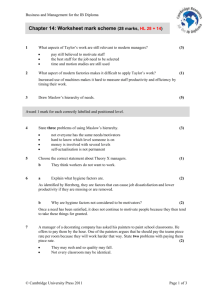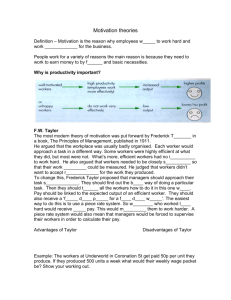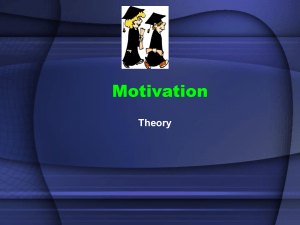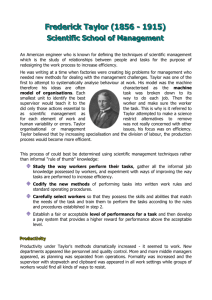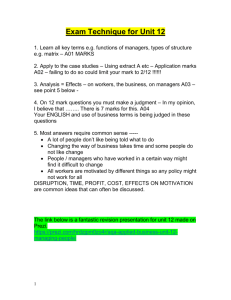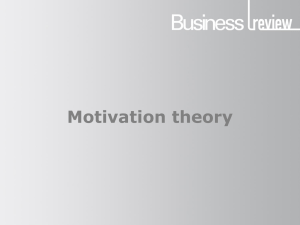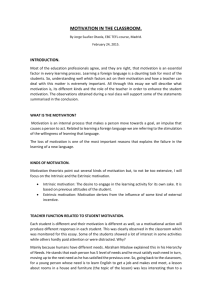Top Management Planning & Strategy: Case Study & Analysis
advertisement
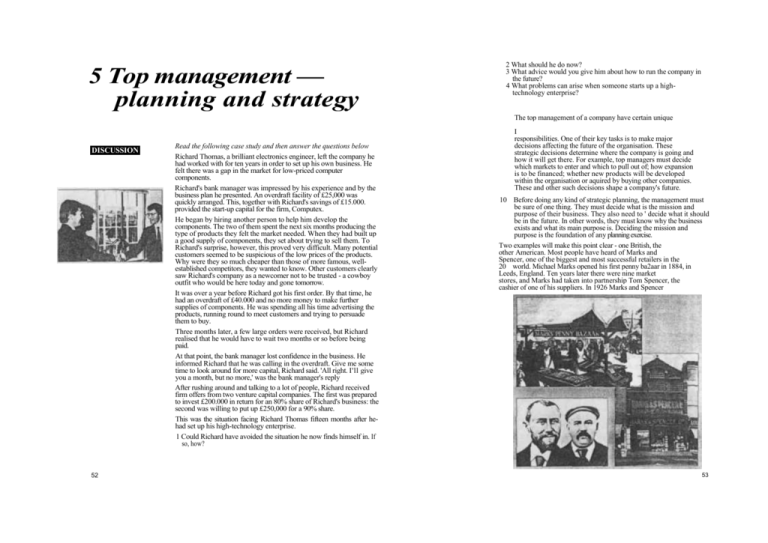
5 Top management — planning and strategy 2 What should he do now? 3 What advice would you give him about how to run the company in the future? 4 What problems can arise when someone starts up a hightechnology enterprise? The top management of a company have certain unique DISCUSSION 52 Read the following case study and then answer the questions below Richard Thomas, a brilliant electronics engineer, left the company he had worked with for ten years in order to set up his own business. He felt there was a gap in the market for low-priced computer components. Richard's bank manager was impressed by his experience and by the business plan he presented. An overdraft facility of £25,000 was quickly arranged. This, together with Richard's savings of £15.000. provided the start-up capital for the firm, Computex. He began by hiring another person to help him develop the components. The two of them spent the next six months producing the type of products they felt the market needed. When they had built up a good supply of components, they set about trying to sell them. To Richard's surprise, however, this proved very difficult. Many potential customers seemed to be suspicious of the low prices of the products. Why were they so much cheaper than those of more famous, wellestablished competitors, they wanted to know. Other customers clearly saw Richard's company as a newcomer not to be trusted - a cowboy outfit who would be here today and gone tomorrow. It was over a year before Richard got his first order. By that time, he had an overdraft of £40.000 and no more money to make further supplies of components. He was spending all his time advertising the products, running round to meet customers and trying to persuade them to buy. Three months later, a few large orders were received, but Richard realised that he would have to wait two months or so before being paid. At that point, the bank manager lost confidence in the business. He informed Richard that he was calling in the overdraft. Give me some time to look around for more capital, Richard said. 'All right. I'll give you a month, but no more,' was the bank manager's reply After rushing around and talking to a lot of people, Richard received firm offers from two venture capital companies. The first was prepared to invest £200.000 in return for an 80% share of Richard's business: the second was willing to put up £250,000 for a 90% share. This was the situation facing Richard Thomas fifteen months after hehad set up his high-technology enterprise. 1 Could Richard have avoided the situation he now finds himself in. If so, how? I responsibilities. One of their key tasks is to make major decisions affecting the future of the organisation. These strategic decisions determine where the company is going and how it will get there. For example, top managers must decide which markets to enter and which to pull out of; how expansion is to be financed; whether new products will be developed within the organisation or aquired by buying other companies. These and other such decisions shape a company's future. 10 Before doing any kind of strategic planning, the management must be sure of one thing. They must decide what is the mission and purpose of their business. They also need to ' decide what it should be in the future. In other words, they must know why the business exists and what its main purpose is. Deciding the mission and purpose is the foundation of any planning exercise. Two examples will make this point clear - one British, the other American. Most people have heard of Marks and Spencer, one of the biggest and most successful retailers in the 20 world. Michael Marks opened his first penny ba2aar in 1884, in Leeds, England. Ten years later there were nine market stores, and Marks had taken into partnership Tom Spencer, the cashier of one of his suppliers. In 1926 Marks and Spencer 53 54 became a public company. At that point, they could have rested on their laurels! However, before deciding strategies, the planners have to look at the company’s present performance, and at any external factors, which might affect its future. To do this, it carries out an analysis, sometimes called a SWOT analysis (Strengths, Weaknesses, Opportunities and Threats). First, the organization examines its current performance, assessing its strengths and weaknesses. It looks as performance indicators and market share, sales revenue, outputs and productivity. It also examines its resources – financial, human, products and facilities. For example a department store chain may have stores in good locations – a strength – but sales revenue per employee may be low – a weakness. Next, the company looks at external factors from the point of view of opportunities and threats. It’s trying to assess technological, social, economic and political trends in the markets, where it is competing. It also examines the activity of the competitors. The department store chain, for example, may see an opportunity to increase profits by providing financial services to customers. On the other hand, increasing competition may be a threat to its very existence. Having completed the SWAT analysis, the company and now revaluates its objectives and perhaps work out new ones. They will ask themselves questions such as: Are we producing the right products? What growth rate should we aim at in the next 5 years? Which new markets should we break into? The remaining task is to develop appropriate strategies to achieve the objectives. The organization decides, what actions it will take and how it will provide the resources to support those actions. One strategy may be to build a new factory to increase production capacity. To finance this, the company may develop another strategy, the issuing of a new shares to the public. Company planning and strategic decision-making a key activities of top management. Once they have been carried out objectives and targets can be set at lower levels of the organization. Understanding the main points 1 Number the following ideas 1-8, depending on the order in which they appear in the text. a The American Telephone and Telegraph Company decided that its principal objective was to provide customers with an efficient service. b The first step in planning the (long-term) future of a company is to decide on its overall objective, c After analysing its strengths, weaknesses, opportunities and threats, an organisation may re-consider its objectives. d The purpose of a corporate plan is to state how management intends to achieve the objectives. e The second planning stage is to establish more specific (medium-term) objectives. f Finally, management needs to decide what actions it should take in order to achieve its objectives. g It is necessary for management to analyse the company's current performance as well as external factors affecting its future before they can draw up a corporate plan. h Marks and Spencer's aim to provide excellent value for money has led to their becoming one of the world's most successful retailers. 2 Consider Computex, the high-technology company mentioned in the discussion on page 52. Note down some of its strengths, weaknesses, opportunities and threats. STRENGTHS WEAKNESSES OPPORTUNITIES THREATS 1 ............... 1 ............... 1 ............... 1 ............... 2 ............... 2 ............... 2 ............... 2. 3 ............... 3 .............. 3 .......... ... 3 ............... 4 ............... 4 ............... 4 ............... 4 .............. .............. . 55 8 Motivation DISCUSSION READING Answer the following questions, then, in groups of two or three, compare your answers. 1 What sort of things motivate people to do their job well? List all the things you can think of. 2 If you won a great deal of money, for example in a lottery, would you continue working? If not, do you think you would lose anything by giving up work? The work of managers is to ensure that staff work efficiently in an organisation. To achieve this, it is clear that managers must know what motivates people. By understanding the factors influencing motivation, they can create the conditions in which employees will perform to their maximum.potential, •One of the best known theories of motivation was put forward by an American psychologist, Abraham Maslow, in a book entitled Motivation and Personality (1954). In his theory, he presents a hierarchy of needs. He identified certain basic human 10 needs and classified them in an ascending order of importance. Basic needs were at the bottom of the hierarchy, higher needs at the top. His classification is shown below: Physiological needs These were things required to sustain life, like food, water, air, sleep etc. Until these needs are satisfied. Maslow believed. other needs will not motivate people. Security needs They are the needs to be free from danger, physical pain and loss of a job. They include the need for clothing and shelter. 20 Social needs A human being needs to belong to a group, to be liked and loved, to feel accepted by others and to develop affiliations. Esteem needs After people have satisfied their social needs, they want to have self-respect and to be esteemed by others. They have a need for power, status, respect and self-confidence. Self-actualisation needs These are the highest needs, according to Maslow. They are the desire to develop, to maximise potential and to achieve; one's goals. Maslow said that people satisfied their needs in a systematic way. When a need had been met, it stopped being a motivating factor. For example, if a person was starving, he would not be too concerned about security and social needs. But once he had enough food, he would start thinking about % those other needs. Research into Maslow's theory has not been very conclusive, Studies have tended to show that needs vary greatly among individuals. At the higher levels in a company, self-actualising 40 needs may be very strong whereas at lower levels, social and security needs may be dominant. Another theory of motivation, which has been very popular with managers, is Frederick Herzberg's 'two-factor' theory. Herzberg conducted a number of studies in the region of Pittsburg, USA; in the late 1950s.'He concluded that at work there are certain factors which cause job satisfaction while others lead to dissatisfaction. The group of factors bringing about satisfaction were called 'motivators'. They include things like a challenging job. 80 responsibility, advancement, recognition etc. These factors give rise to positive satisfaction. Herzberg called the other group of factors 'hygiene' or 'maintenance' factors. These '; include company policy and administration, salary and fringe . * benefits, job security, status and personal life. These factors , are considered to be only 'dissatisfiers', not motivators. If they do not exist, they cause dissatisfaction. If they do exist in quality and quantity, they do not. however, give increased satisfaction. Herzberg's two-factor theory is shown in the following diagram. 60 , It is worth noting that the hygiene factors refer to the context of the job - the conditions of work - while the motivators refer to job content. 90 Herzbefg's motivation-hygiene theory motivators hygiene factors achievement challenging work the work itself career prospects responsibility recognition company policy and administration salary and fringe benefits quality of supervision relationship with colleagues job security status personal life work conditions Hygiene factors are essential if workers are to be motivated. As one writer has aptly, put it they deal with the question 'Why work here?'. The motivators deal with the question 'Why work harder?' If Herzberg's theory is true, it means that-managers must pay great attention to job content. They must find ways of making jobs more challenging and interesting. As a result, managers 70 in the USA and elsewhere have recently, been showing great interest in job enrichment programmes. The idea of such programmes is to make jobs more challenging and to give the workers sense of achievement. Sweden has been leading the way in this respect. At one car . plant, for example, Volvo, workers assemble the whole of a car rather than do a few simple operations. In a. glass factory, production workers have complete control over the work process in the grinding and polishing department. Other workers have helped to build and design paper mills. Job 80 enrichment is undoubtedly catching on fast in Sweden. Understanding the main points Decide whether the following statements are true or false. True False 1 According to Maslow people are not concerned about achieving their personal goals in life unless they have satisfied their physiological needs. 2 Senior managers who want to become company directors have self-actualisation needs which they wish to satisfy. 3 Herzberg, like Maslow, believes that people satisfy their needs systematically. 4 Herzberg believed that workers would not necessarily work harder if they earned more money. 5 Job security is one of the most important factors which motivates employees. 6 The purpose of job enrichment programmes is to increase worker motivation. 1c Reading Read the text below, about different ways of organizing companies, and then label the diagrams, according to which of these they illustrate: line structure functional matrix structure s staff structure t r u c t u r e Businesses that cannot be divided into autonomous divisions with their own markets can simulate decentralization, setting up divisions that deal with each other using internally determined transfer prices. Many banks, for example, have established commercial, corporate, private banking, international and investment divisions. An inherent problem of hierarchies is that people at lower levels are unable to make important decisions, but have to pass on responsibility to their boss. One solution to this is matrix management, in which people report to more than one superior. For example, a product manager with an idea might be able to deal directly with managers responsible for a certain market segment and for a geographical region, as well as the managers responsible for the traditional functions of finance, sales and production. This is one way of keeping authority at lower levels, but it is not necessarily a very efficient one. Thomas Peters and Robert Waterman, in their wellknown book In Search of Excellence, insist on the necessity of pushing authority and autonomy down the line, but they argue that one element - probably the product - must have priority; fourdimensional matrices are far too complex. A further possibility is to have wholly autonomous, temporary groups or teams that are responsible for an entire project, and are split up as soon as it is successfully completed. Teams are often not very good for decision-making, and they run the risk of relational problems, unless they are small and have a lot of self-discipline. In fact they still require a definite leader, on whom their success probably depends. 1d Comprehension Which of the following three paragraphs most accurately summarizes the text, and why? COMPANY STRUCTURE Most organizations have a hierarchical or pyramidal structure, with one person or a group of people at the top, and an increasing number of people below them at each successive level. There is a clear line or chain of command running down the pyramid. All the people in the organization know what decisions they are able to make, who their superior (or boss) is (to whom they report), and who their immediate subordinates are (to whom they can give instructions). Some people in an organization have colleagues who help them: for example, there might be an Assistant to the Marketing Manager. This is known as a staff position: its holder has no line authority, and is not integrated into the chain of command, unlike, for example, the Assistant Marketing Manager, who is number two in the marketing department. Yet the activities of most companies are too complicated to be organized in a single hierarchy. Shortly before the first world war, the French industrialist Henry Fayol organized his coal-mining business according to the functions that it had to carry out. He is generally credited with inventing functional organization. Today, most large manufacturing organizations have a functional structure, including (among others) production, finance, marketing, sales, and personnel or staff departments. This means, for example, that the production and marketing departments cannot take financial decisions without consulting the finance department. Functional organization is efficient, but there are two standard criticisms. Firstly, people are usually more concerned with the success of their department than that of the company, so there are permanent battles between, for example, finance and marketing, or marketing and production, which have incompatible goals. Secondly, separating functions is unlikely to encourage innovation. Yet for a large organization manufacturing a range of products, having a single production department is generally inefficient. Consequently, most large companies are decentralized, following the model of Alfred Sloan, who divided General Motors into separate operating divisions in 1920. Each division had its own engineering, production and sales departments, made a different category of car (but with some overlap, to encourage internal competition), and was expected to make a profit. First summary: Although most organizations are hierarchical, with a number of levels, and a line of command running from the top to the bottom, hierarchies should be avoided because they make decision-making slow and difficult. A solution to this problem is matrix management, which allows people from the traditional functional departments of production, finance, marketing, sales, etc. to work together in teams. Another solution is decentralization: the separation of the organization into competing autonomous divisions. Second summary: Most business organizations have a hierarchy consisting of several levels and a clear line of command. There may also be staff positions that are not integrated into the hierarchy. The organization might also be divided into functional departments, such as production, finance, marketing, sales and personnel. Larger organizations are often further divided int o autonomous divisions, each with its own functional sections. More recent organizational systems include matrix management and teams, both of which combine people from different functions and keep decision-making at lower levels. 10 2 Frederick W. Taylor: Scientific Management DISCUSSION Read the following information about IBM's methods of work and • then discuss the questions below. In his book Management Peter Drucker makes some comments about the workers who produce IBM's equipment. He says that IBM made a conscious effort to make their jobs big. Take, for example, the machine operators. Although the operations they perform are designed to be simple, the workers do a number of different tasks, of which at least one requires skill and judgement on the worker's part. Also, because of the range of his/her tasks, the worker is able to change the pace at which he/she works. Drucker says interesting things about other IBM methods. The way the company develops new products is worth noting. Before the engineering of the new product is finished, the project is given over to one of the foremen, who then manages it. So, the final details of the engineering design are worked out on the shop floor with the engineer and workers who will make the machine. IBM production workers are not told what production rate they must achieve. They work out a rate with their foreman. IBM says that there is no such thing as a production norm. Each man works out for himself, with his superior's help, the speed and flow of work that will give him the most production. 1 What are the advantages of making the jobs of production workers big? Are there any disadvantages? 2 Why, do you think, does IBM develop new products in the manner described? 3 What do we learn about (i) IBM's attitude towards its production workers? (ii) the company's style of management? No one has had more influence on managers in the twentieth century than Frederick W. Taylor, an American engineer. He set a pattern for industrial work which many others have followed, and although his approach to management has been criticised, his ideas are still of practical importance. Taylor founded the school of Scientific Management just before ; the 1914-18 war. He argued that work should be studied and analysed systematically. The operations required to perform a particular job could be identified, then arranged in a logical I 10 sequence. After this was done, a worker's productivity would I increase, and so would his/her wages. The new method was scientific. The way of doing a job would no longer be determined by guesswork and rule-of-thumb practices. ; Instead, management would work out scientifically the method for producing the best results. If the worker followed the prescribed approach, his/her output would increase. When Taylor started work at the end of the nineteenth century, the industrial revolution was in full swing. Factories were being set up all over the USA. There was heavy investment in 20 plant and machinery, and labour was plentiful. He worked for twenty years (1878-1898) with the Midvale Steel Company, first as a labourer, then as a Shop Superintendant. After that, he was a consultant with the Bethlehem Steel Company in Pennsylvania. Throughout this time, he studied how to improve the efficiency of workers on the shop floor. He conducted many experiments to find out how to improve their productivity. His solutions to these problems were, therefore, based on his own experience. Later, he wrote about his experiments. These writings were collected and published in 1947. in a work entitled Scientific 30 Management. When he was with Bethlehem Steel, Taylor criticised management and workers. He felt that managers were not using the right methods and that workers did not put much effort into their job. They were always 'soldiering' - taking it easy. He wanted both groups to adopt a new approach to their work, which would change their thinking completely. The new way was as follows: 1 Each operation of a job was studied and analysed, 2 Using this information, management worked out the time and 40 method for each job, and the type of equipment to be used; 3 Work was organised so that the worker's only responsibility was to do the job in the prescribed manner; 4 Men with the right physical skills were selected and trained for the job. Observing; analysing; measuring; specifying the work method; organising and choosing the right person for the job -these were the tasks of management. Taylor's approach produced results! For example, at Bethlehem Steel, he did an experiment with shovels, the tool 50 used for lifting and carrying materials. He studied the work of two first-class shovellers and then changed their working procedure. In the beginning, the men used their own shovels for all the types of materials they handled, whether coal or 18 19 iron ore. The average load was 38 pounds, and each lifted 25 tons of material a day. By experimenting, Taylor found out that if the men used smaller shovels and carried 21 pounds per load, their daily output increased to 30 tons. As a result, at the beginning of each shift, workers were given different sized shovels, depending on the type of material they loaded, but 60 the load was still 21 pounds. Other workers meeting the ' standards set by the two shovellers had their wages increased by 60%. Those who could not reach the standard were given special training in shovelling techniques. 2 Complete the following table. Frederick W. Taylor: Scientific Management (1947) By introducing methods like these, Taylor and his colleagues greatly increased productivity at Bethlehem Steel. After a few years, the same amount of work was done by 140 workers instead of 500. Handling costs of materials were halved, which led to annual savings of $80,000. Taylor made a lasting contribution to management thinking. 70 His main insight, that work can be systematically studied in order to improve working methods and productivity, was revolutionary. Also, he correctly emphasised that detailed planning of jobs was necessary. The weakness of his approach was that it focused on the system of work rather than on the worker. With this system the worker becomes a tool in the hands of management. It is assumed he/she will do the same boring, repetitive job hour after hour, day after day while maintaining a high level of productivity. Another criticism is that it leads to de-stalling -80 reducing the skills of workers. Because the tasks are simplified, workers become frustrated. And with educational standards rising among factory workers, dissatisfaction is likely to increase. Finally, some people think that it is wrong to separate doing from planning. The two tasks can, and should, be done by the same person. A worker will be more productive if he/she is engaged in such activities as planning, decision-making, controlling and organising. For all these reasons, a reaction has set in against the ideas of Frederick W. Taylor. Understanding the main points 1 Complete the following sentences, using your own words. 1 Taylor's method of management was revolutionary because 2 Companies which adopted this new approach to management would benefit because .......................................................... 3 Scientific Management would also be a good thing for workers because ................................................................................... 4 At Bethlehem Steel Taylor decided to give workers smaller shovels so that .................................................................. 5 As a result of the new working procedures introduced at Bethlehem Steel, within a few years the company....................... 20 ADVANTAGES DISADVANTAGES 1 ......................................... 1 ............................... 2 ......................................... 2 .............................. 3 ......................................... 3 ......................................... Vocabulary focus 1 Find words or phrases in the text which mean the same as the following: 1 making a judgement without being certain (paragraph 2) 2 calculate (paragraph 2) 3 quantity of goods produced (paragraph 2) 4 established (paragraph 3) 5 amount to be carried (paragraph 6) 6 fixed period of time worked each day, especially for factory workers (paragraph 6) 7 perception, clear realisation, deep understanding (paragraph 8) 2 What is the meaning of the shop floor (line 25)? 1 LANGUAGE STUDY Complete the following chart. PERSON manager managing NOUN management VERB manage ADJECTIVE managerial or criticise performer science training | analytical industry observe engineering revolutionary consult manage m e n t 1.1 What is Management? Complete the text using these verbs: analyse communicate contribute improve measure commercialise perform risk select train understand use work out divide form You want me to explain what management is? Well, I guess 1 can manage that! Actually, management as we (1) . . . . it today is a fairly recent idea. Most economists in the eighteenth and nineteenth centuries, for example, wrote about factors of production such as land, labour and capital, and about supply and demand, as it these were impersonal and objective economic forces which left no room for human action. An exception was Jean-Baptiste Say, who invented the term "entrepreneur", the person who sees opportunities to (2) . . . . resources in more productive ways. Entrepreneurs are people who are alert to so-far undiscovered profit opportunities. They perceive opportunities to (3). . . new technologies and products that will serve the market better than it is currently being served by their competitors. They are happy to (4) ...... their own or other people's capital. They are frequently unconventional, innovative people. But entrepreneurship isn't the same as management, and most managers aren't entrepreneurs. So, what's management? Well, it's essentially a matter of organizing people. Managers, especially senior managers, have to set objectives tor their organization, and then (5) . . how to achieve them. This is true of the managers of business enterprises, government departments, educational institutions, and sports teams, although for government services, universities and so on we usually talk about administrators and administration rather than managers and management. Managers (6) . . . . . . . . . the activities of the organization and the relations among them. They ( 7 ) . the work into distinct activities and then into individual jobs. They (8) . . . people to manage these activities and perform the jobs. And they often need to make the people responsible for performing individual jobs (9) . . . effective teams. Managers have to be good at communication and motivation. They need to (10) ...... the organization's objectives to the people responsible for attaining them. They have to motivate their staff to work well, to be productive, and to ( 1 1 ) . something to the organization. They make decisions about pay and promotion. Managers also have to (1 2 ) . the performance of their staff, and to ensure that the objectives and performance targets set for the whole organization and for individual employees are reached. Furthermore, they have to (13) .... . . and develop their staff, so that their performance continues to (1 4 ) ...... Some managers obviously ( 1 5 ) . . . . . . these tasks better than others. Most achievements and failures in business are the achievements or failures of individual managers. When you have checked your answers, translate the highlighted expressions into your own language. UNIT 2 Management 1 Management - an art or a science? 1a Discussion 1b Reading This text summarizes some of Peter Drucker's views on management. As you read about his description of the work of a manager, decide whether the five different functions he mentions require the four qualities you selected in your discussion, or others you did not choose. WHAT IS MANAGEMENT? Peter Drucker, the well-known American business professor and consultant, suggests that the work of a manager can be divided into planning (setting objectives), organizing, integrating (motivating and communicating), measuring, and developing people. • First, of all, managers (especially senior managers such as company chairmen - and women and directors) set objectives, and decide how their organization can achieve them. This involves developing strategies, plans and precise tactics, and allocating resources of people and money. • Secondly, managers organize. They analyse and classify the activities of the organization and the relations among them. They divide the work into manageable activities and then into individual jobs. They select people to manage these units and perform the jobs. • Thirdly, managers practise the social skills of motivation and communication. They also have to communicate objectives to the people responsible for attaining them. They have to make the people who are responsible for performing individual jobs form teams. They make decisions about pay and promotion. As well as organizing and supervising the work of their subordinates, they have to work with people in other areas and functions. • Fourthly, managers have to measure the performance of their staff, to see whether the objectives (Set for the organization as a whole and for each individual member of it are being achieved. • Lastly, managers develop people - both their subordinates and themselves. 1 What is management? Is it an art or a science? An instinct or a set of skills and techniques that can be taught? 2 What do you think makes a good manager? Which four of the following qualities do you think are the most important? A being decisive: able to make quick decisions B being efficient: doing things quickly, not leaving tasks unfinished, having a tidy desk, and so on C being friendly and sociable D being able to communicate with people E being logical, rational and analytical F being able to motivate and inspire and lead people G being authoritative: able to give orders H being competent: knowing one's job perfectly, as well as the work of one's subordinates I being persuasive: able to convince people to do things J having good ideas Are there any qualities that you thi nk should be added to this list? 3 Which of these qualities can be acquired? Which must you be born with? Obviously, objectives occasionally have to be modified or changed. It is generally the job of a company's top managers to consider the needs of the future, and to take responsibility for innovation, without which any organization can only expect a limited We. Top managers also have to manage a business's relations with customers, suppliers, distributors, bankers, investors, neighbouring communities, public authorities, and so on, as well as deal with any major crises which arise. Top managers are appointed and supervised and advised (and dismissed) by a company's board of directors. Although the tasks of a manager can be analysed and classified in this fashion. management is not entirely scientific. It is a human skill. Business professors obviously believe that intuition and 'instinct' are not enough; there are management skills that have to be learnt. Drucker, for example, wrote over 20 years ago that 'Altogether this entire book is based on the proposition that the days of the "intuitive" manager are numbered,'* meaning that they were coming to an end. But some people are clearly good at management, and others are not. Some people will be unable to put management techniques into practice. Others will have lots of technique, but few good ideas. Outstanding managers are rather rare. Peter Drucker: An Introductory View of Management Management 1 3 Evaluation III. Evaluating the option So I'd say that was the least favour- I agree with X able option for us. Reason Reaction 1. Making an opening statement I think the main weakness of this for us is that... The problem with licensing So I would rank it as a fairly unattrac- Yes. I think that fits is that... tive option. Language Checklist in with the way we look at this situation too. Welcoming Welcome to... I'm sure we will have a useful and productive meeting First meeting We see this as a preparatory meeting... We would like to reach agreement on... Reason Evaluation 1 think that's got a lot of potential. The main strength of the project is that... I have some doubts about this option. I'm not sure how to react to that suggestion. I feel we should go even further than that. The main strength of this, from our point of view, is that... The main strength of this, as we see it, is that... I think it fits in with the way we look at it. My immediate feeling is that it doesn't fit in with our philosophy. IV. Handling over I'd like to finish there and give you the opportunity to reply to this I'd like to hand over to my colleague..., who has something to say about... What is your opinion about ....? Reaction Yes, we are also interested in close cooperation, but... One of the series of meetings Following previous meetings we have agreed on some important issues. Today we have to think about... We have reached an important stage... II. Stating your aims and objectives I I'd like to begin with a few words about our general expectations... May I outline our principle aims and objectives today... We want to clarify our positions... We have a formal agenda... We don't have a formal agenda, but we hope to reach agreement on... There are three specific areas we would like to discuss. These are... We have to decide... I'd like to start by suggesting... How about trying...? How about using...? It seems to me that there are a number of ways we could work together There seem to be several possibilities lor working more closely together. Shall / I suggest / we list the options list and then examine them in more detail one by one Should we brainstorm the options before we discuss any in detail? Have you considered the idea of...? We could also... Why don't we go through each of these in more detail... At this stage I think we should look at each option in turn.
